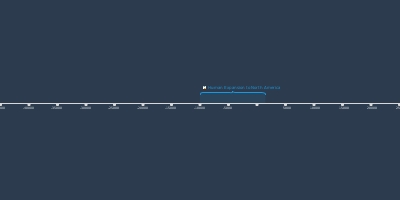European 'Discovery' of North America (oct 12, 986 – oct 1, 1542)
Description:
The first official documented case of a European culture ‘discovering’ North America was not done until the 700s. It was done by a culture called Norsemen (sometimes also Vikings), and they found the British Isles and Iceland. Soon after, one Viking known as Leif Erikson began exploring the Eastern Coast of North America, and established a settlement he called Vinland; which is located on the northern tip of Newfoundland. (Belshaw, ch. 3.2) The discovery that many people associate as the ‘discovery’ of North America though, was one by an Italian explorer, sailing under Spanish flag. His name was Christopher Columbus, and he landed in the Bahamas on October 12th, 1492, convinced he was actually in Asia. (Belshaw, ch. 3.3) Once the first European country landed on North American soil, it started a race to conquer, settle, and colonize North America, for use of resources, land area, and overall domination of the world. While Spain and Portugal got a head start in the Americas, France and England were the next to begin ‘discovering’ much of North America. The first voyages from France were led by a man named Jacques Cartier, during a span of eight years between 1534 and 1542. (Belshaw, ch. 3.6) Cartier created a few small settlements during his time in North America. Stadacona and Hochelaga were a couple of the more fortified and larger settlements. (Belshaw, ch. 3.6) These early expeditions into North America jump-started a new found curiosity on the world and sent many European people to North America. Soon enough North America would become a hub of activity for both the Indigenous peoples, their interactions with Europeans, and the European settlement and colonization of North America that would change Indigenous society, and the political landscape of North America for the years to come.Added to timeline:
Date:
oct 12, 986
oct 1, 1542
~ 556 years
